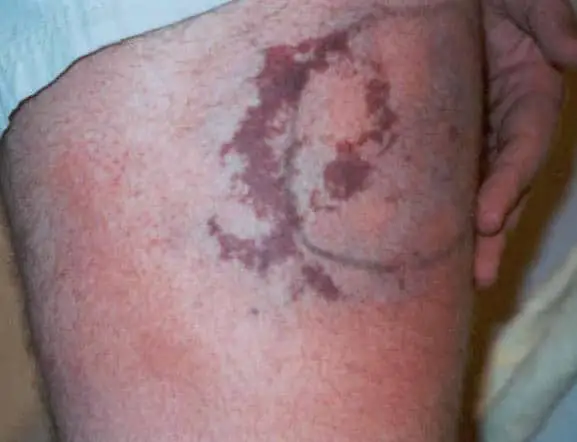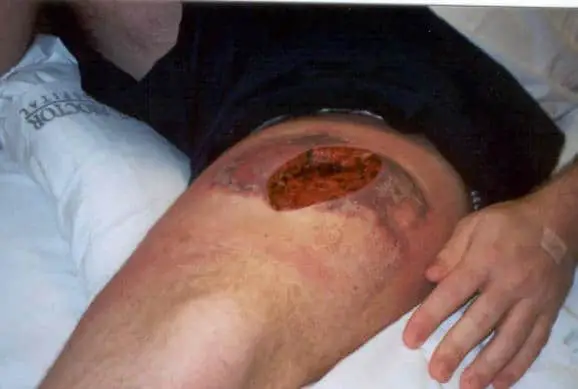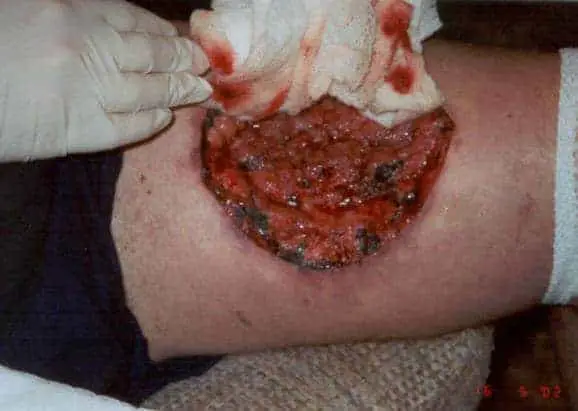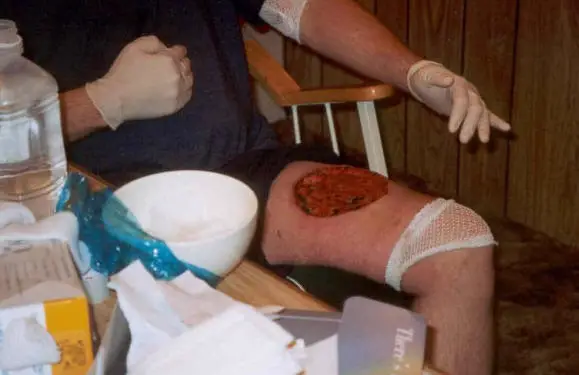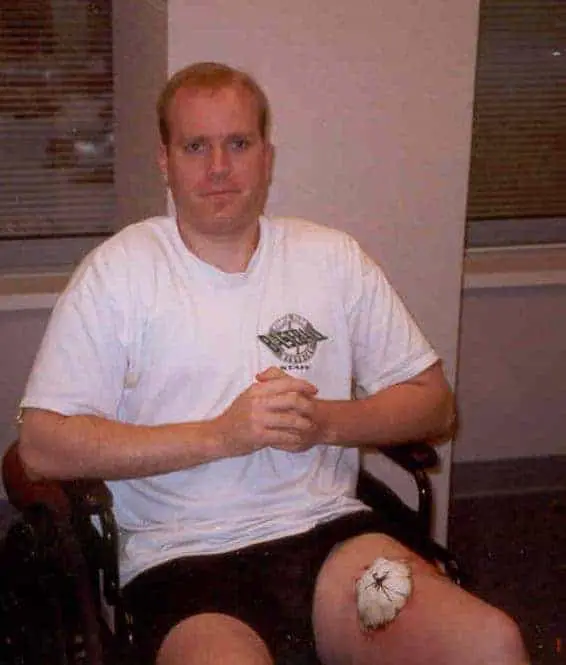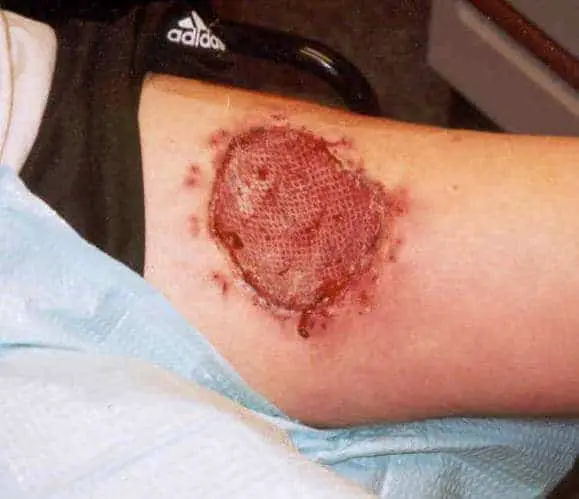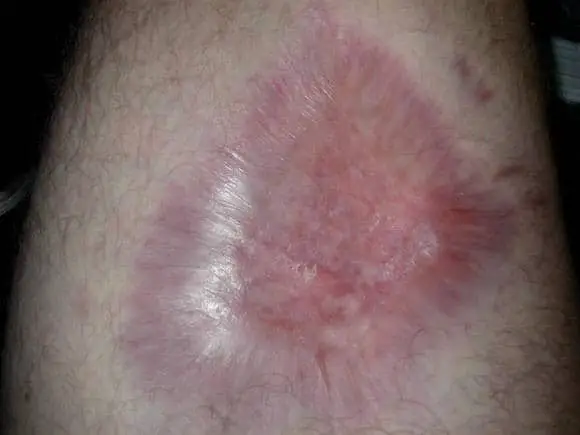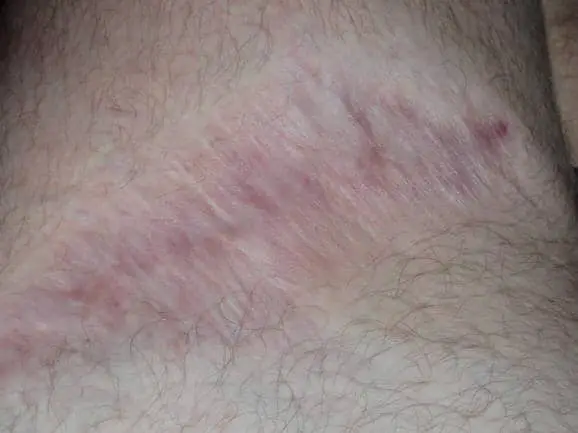In this post, you can find a news article and photos of a brown recluse bite. While we generally advocate that the reputation of the brown recluse is worse than reality, these photos show that they are still dangerous animals and should not be taken lightly.
Deadly spiders attack man – Pekinite suffers multiple bites from brown recluse spiders
June 25, 2002 – By ELAINE HOPKINS of the Journal Star
PEKIN – For the second time this year, a Pekin resident has been bitten by a brown recluse spider.
Thirty-year-old Miles Andy Plymale was in Pekin Hospital on Monday, suffering from spider bites on both hands and a rash that has spread over his upper body. A doctor has told him he will not lose his hands, Plymale said, but he was in severe pain.
From his hospital bed, Plymale wanted people to know these creatures are abundant this year because of the mild winter. Children could be especially vulnerable, he said.
“For anybody working in your yard, spray for spiders,” he said.
Plymale operates his own business, Handy Andy’s Home Repair. He was working June 17 at an address on 12th Street in Pekin when he was bitten on the hands as he was digging out rocks and roots, he said. He killed some of the creatures but others bit him. He identified the spiders as brown recluse.
Although he worked the next day, by Wednesday Plymale was sick and sought care at Pekin Hospital. Doctors gave him a painkiller and antibiotic, and sent him home, he said, even though he told them about the spider bites.
He grew worse and went back to the hospital Thursday, he said, and even sought care from a specialist in Peoria, who gave him some cream and pills and sent him home.
“That did no good,” he said.
By Saturday, Plymale was so sick he went back to Pekin Hospital and was hospitalized, he said.
He has had a severe reaction to the bites.
“Now it’s in God’s hands,” he said of his recovery, adding he does not have any medical insurance, and his business is on hold until he recovers.
On May 6, a brown recluse spider bit Dale Losher in his Pekin apartment. Losher, 30, required four operations and spent eight days in a hospital. Doctors had to remove dead flesh from the 10-inch lesion on his thigh. A spider bit Losher after he picked up a quilt from the floor for extra cover during the night.
In an e-mail note Monday, Losher stated he is going back to work after 48 days of recovery.
The venomous spider can be found mostly in the South and Midwest, especially Arkansas, Oklahoma and Missouri but can be found in areas from Florida to Texas, and north to Iowa and Indiana, according to the U.S. Department of Health and Human Services. The brown recluse may have a dark, violin-shaped area on its back, which is why it is often called fiddlebacks or violin spider.
The spider’s venom contains an enzyme that destroys cell membranes in the wound area with affected tissue gradually sloughing away, exposing underlying tissues. Within 24 hours, the bite site can erupt into a “volcano lesion,” a hole in the flesh due to damaged, gangrenous tissue. The open wound may range from the size of an adult’s thumbnail to the span of a hand. The sunken, ulcerating sore may heal slowly for up eight weeks. Full recovery may take several months and scarring may remain. Plastic surgery and skin grafts are sometimes required.
The University of Kansas, which operates a Web site on these spiders, recently issued a news release urging people to save the creature that bites them so the spider can be identified.
If you’re bitten, it stated, put ice on the wound to slow down activation of the venom, and see a doctor immediately.
People should shake out clothing and shoes before putting them on, and wear gloves when working where the spiders might lurk, it said.


